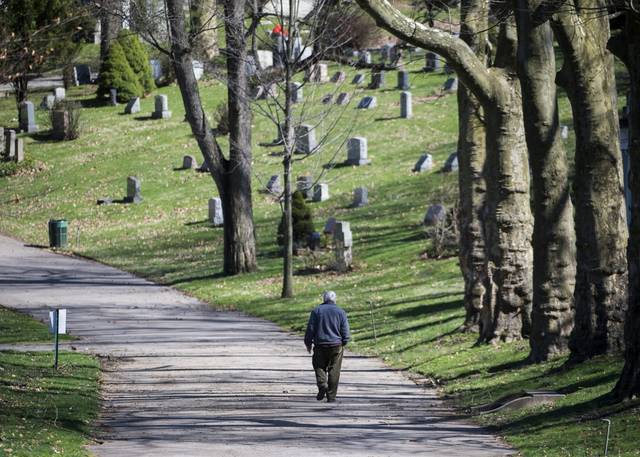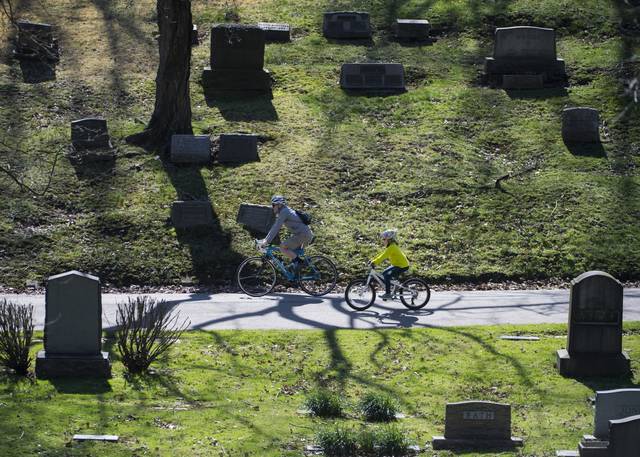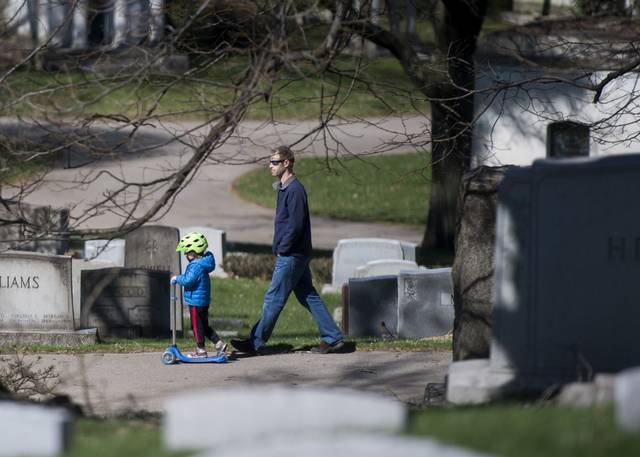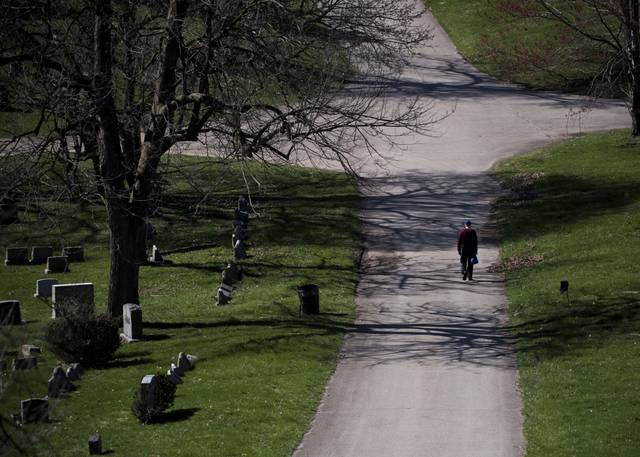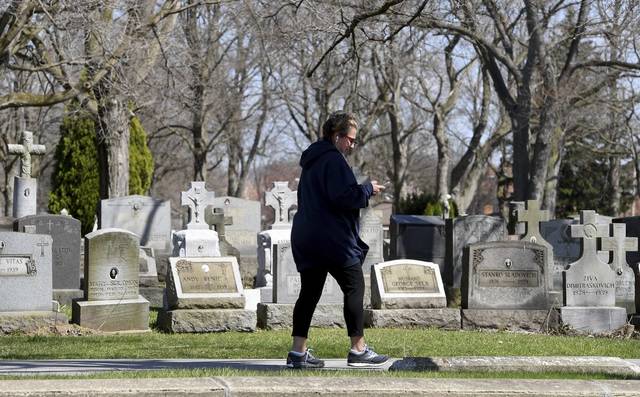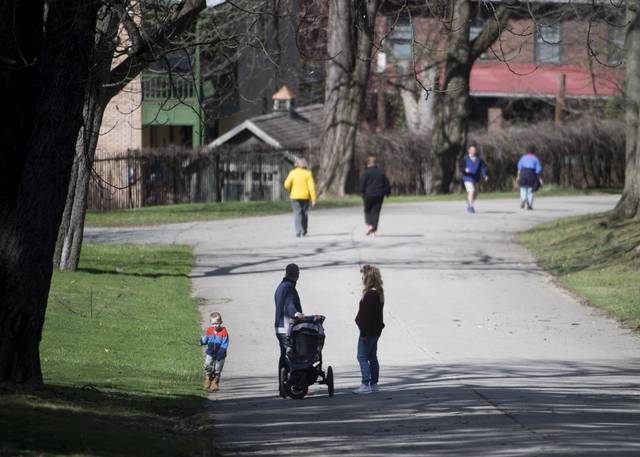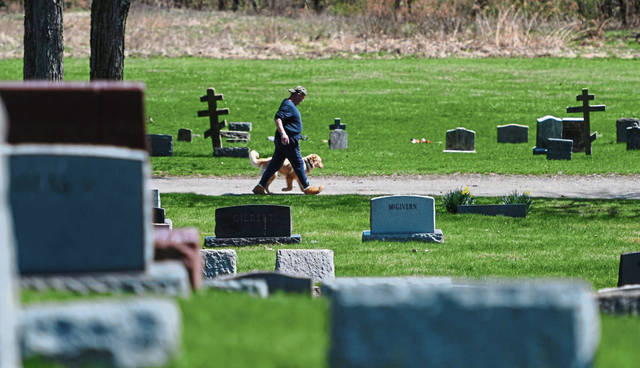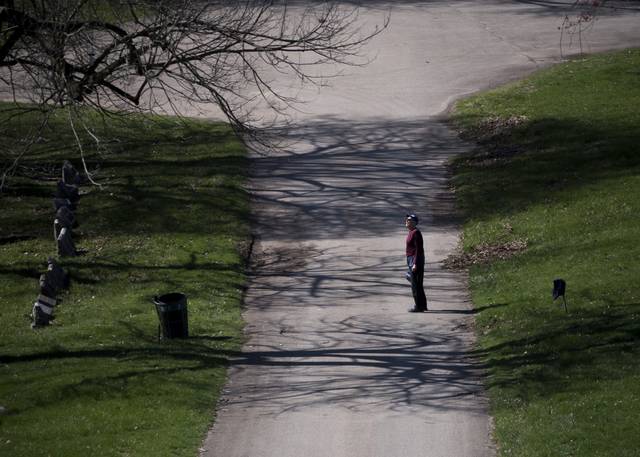Western Pa. cemeteries attract more visitors during coronavirus restrictions
Cemeteries across the region have sprung to life during the coronavirus pandemic, with more people than usual flocking to them for fresh air and exercise.
Some, however, aren’t as serene as they were before the pandemic.
Homestead’s John English, a frequent visitor to Homewood Cemetery in Pittsburgh’s Point Breeze neighborhood, said he turned around his car and left after arriving one day last week because there were so many people.
“There were more live people there than dead,” English said of the historic cemetery founded in 1878 that also is a certified arboretum.
On a sunny but windy Friday, more than three dozen people were in the popular East End cemetery at midday — not including workers or a small group of mourners attending a burial. The other visitors, some alone and others in small groups, walked, jogged or rode bikes along the miles of paths in the 200-acre cemetery that holds thousands of graves, including some of Pittsburgh’s most notable names: Benedum, Bigelow, Frick, Heinz, Mellon and Wilkins, among others.
David Michener, president and CEO of the Allegheny and Homewood cemeteries, said there has been “an increase in people walking (at the cemeteries) and we are not encouraging more people to come.”
While Allegheny Cemetery in Pittsburgh’s Lawrenceville section — America’s sixth-oldest rural cemetery, founded in 1844 — long has been popular with walkers and photographers, Michener said he is committed to “maintain a delicate balance honoring those families who are visiting (loved ones) and keeping our employees safe.”
Other cemeteries, however, are welcoming the increased foot traffic.
“We are inviting the public to visit because there’s a lot of history here,” said Marie Charles, 84, treasurer of the Springdale Cemetery Association.
The small cemetery off School Street sits near the top of a hill providing panoramic views of Springdale and is peppered with flowering ornamental fruit trees and bunches of daffodils donated years ago. A black granite marker atop a common grave memorializes people buried there during the Spanish flu pandemic of 1918.
“It’s a pretty cemetery, it’s an old cemetery and in the spring if you start at the bottom of the hill and walk up to see all the violets, it looks like God laid a purple carpet down,” Charles said.
Prospect Cemetery in Brackenridge, the final resting place of many local leaders, legends and 754 veterans going back to the Revolutionary War, also welcomes the increased traffic.
“Circumstances beyond our control have people looking for things to do and we welcome them to come to the cemetery,” said Cindy Homburg, president of the cemetery’s association.
She urged visitors to stay away from grounds crew members, clean up after their dogs and not show up in groups.
Twin Valley Memorial Park in Delmont also is popular with walkers.
“We’ve always had a lot of people walking here,” said Dan Vaia, president of Twin Valley Memorial Park Corp. “We’ve always had a lot of seniors, but lately we’ve seen some more families with younger kids. I don’t know that we’ve seen an increase, but we’ve seen a different age group. I think it’s the quiet atmosphere that really draws people.”
Mike and Suzanne Dominick live nearby and walk around the cemetery often, including Thursday.
“It’s beautiful and peaceful, and it’s well-maintained,” Suzanne Dominick said. “We come here about four times a week.”
Enjoying the serenity of cemeteries, along with the interesting architecture of headstones and splendor of rolling hills found in many of them, is nothing new.
Before rural cemeteries proliferated outside of city boundaries after the 1830s, during epidemics of yellow fever and cholera, crowded cemeteries in cities were seen as “centers for the gathering of these diseases and their dissemination,” according to Keith Eggener, author of “Cemeteries,” in a 2011 interview with The Atlantic.
Remove the ads from your TribLIVE reading experience but still support the journalists who create the content with TribLIVE Ad-Free.

